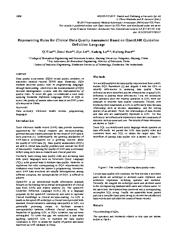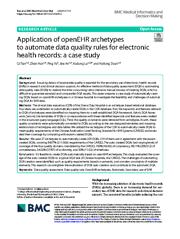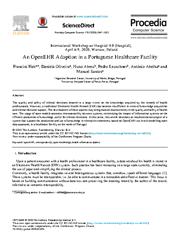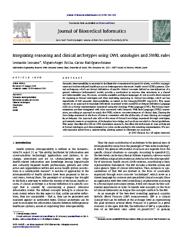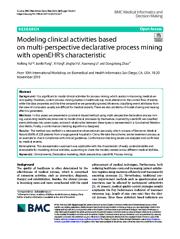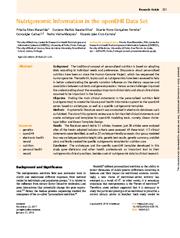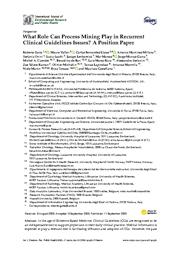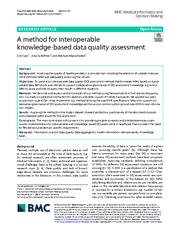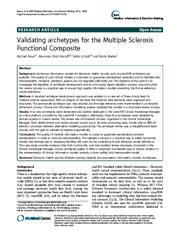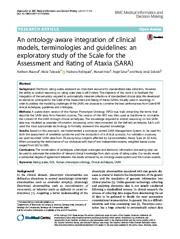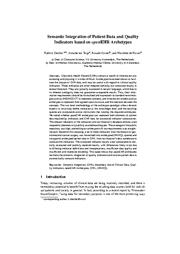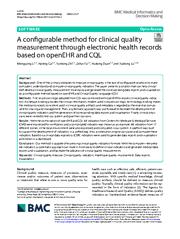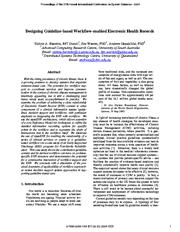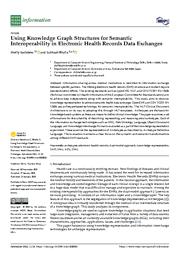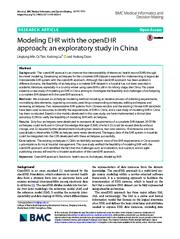A copy of this work was available on the public web and has been preserved in the Wayback Machine. The capture dates from 2022; you can also visit the original URL.
The file type is application/pdf.
Filters
Representing Rules for Clinical Data Quality Assessment Based on OpenEHR Guideline Definition Language
2019
Studies in Health Technology and Informatics
To cover this gap, we conducted a case study applying Guideline Definition Language (GDL) in DQA to assess the quality of patient admission data in an EHR system of a hospital in China. ...
Data quality assessments (DQA) reveal quality problems in electronic medical records (EHR) data. ...
Tian et al. / Representing Rules for Clinical Data Quality Assessment Based on OpenEHR Guideline Definition Language 1607 ...
doi:10.3233/shti190557
pmid:31438254
fatcat:dsxzpy6szjewrgz6k3uw5zieja
Application of openEHR archetypes to automate data quality rules for electronic health records: a case study
2021
BMC Medical Informatics and Decision Making
An effective method of data quality assessment (DQA) is automating data quality rules (DQRs) to replace the time-consuming, labor-intensive manual process of creating DQRs, which is difficult to guarantee ...
This paper presents a case study of automatically creating DQRs based on openEHR archetypes in a Chinese hospital to investigate the feasibility and challenges of automating DQA for EHR data. ...
Therefore, effective data quality assessment (DQA) to ensure adequate data quality is essential for reusing EHR data. This has seen increasing attention to clinical data quality assessment [5] . ...
doi:10.1186/s12911-021-01481-2
pmid:33812388
fatcat:mgakmuvrnjaorpmyh37o2ac4bq
An OpenEHR Adoption in a Portuguese Healthcare Facility
2020
Procedia Computer Science
In this sense, this article describes an implementation project of a system that support the production and use of knowledge in clinical environments, based on OpenEHR two levels modelling open data approach ...
In this sense, this article describes an implementation project of a system that support the production and use of knowledge in clinical environments, based on OpenEHR two levels modelling open data approach ...
Regarding the definition of the intervening parts of the process, a modelling team was created for OpenEHR clinical data modelling. ...
doi:10.1016/j.procs.2020.03.075
fatcat:waohvx756rf5vl4vvufqfapcde
Integrating reasoning and clinical archetypes using OWL ontologies and SWRL rules
2011
Journal of Biomedical Informatics
This paper reports on an approach to translate definitions expressed in the openEHR Archetype Definition Language (ADL) to a formal representation expressed using the Ontology Web Language (OWL). ...
The formal representations are then integrated with rules expressed with Semantic Web Rule Language (SWRL) expressions, providing an approach to apply the SWRL rules to concrete instances of clinical data ...
a flexible approach for reusing declarative knowledge, as the one that is commonly found in clinical guidelines, in the form of rules. ...
doi:10.1016/j.jbi.2010.11.005
pmid:21118725
fatcat:gjalew7rtzc4dn3s25rv4fys6q
Modeling clinical activities based on multi-perspective declarative process mining with openEHR's characteristic
2020
BMC Medical Informatics and Decision Making
It is significant to model clinical activities for process mining, which assists in improving medical service quality. ...
Inspired by openEHR, we classified event attributes into seven types, and each relationship between these types is represented in a Constrained Relationship Matrix. ...
Acknowledgements We are grateful to General Hospital of Xinjiang Military Region for their allowance to analyze the EMR data. ...
doi:10.1186/s12911-020-01323-7
pmid:33323101
fatcat:3brbl6kfmjdcpos4o7fst7xqye
Nutrigenomic Information in the openEHR Data Set
2018
Applied Clinical Informatics
Objective Finding the main clinical statements in the personalized nutrition field (nutrigenomics) to create the future-proof health information system to the openEHR server based on archetypes, as well ...
set of nutrigenomic data to clinical research. ...
such as terminologies and clinical guidelines; providing wide geographical availability of a given record to multiple careers and applications; being consent-based-privacy rules on information use (except ...
doi:10.1055/s-0038-1635115
pmid:29590680
pmcid:PMC5874138
fatcat:gygxqyeoqrdmfbvmnafrw2x2cu
What Role Can Process Mining Play in Recurrent Clinical Guidelines Issues? A Position Paper
2020
International Journal of Environmental Research and Public Health
In the age of Evidence-Based Medicine, Clinical Guidelines (CGs) are recognized to be an indispensable tool to support physicians in their daily clinical practice. ...
Which role does PM4HC play and which rules should be employed for the PM4HC scientific community? ...
In doing that, the authors will take inspiration from initiatives such as Magic (http://magicproject.org/) [115] that developed frameworks for rapidly producing validate evidence and testing CDSS interventions ...
doi:10.3390/ijerph17186616
pmid:32932877
fatcat:nvups3g6ifa77clfinvev7jrvm
A method for interoperable knowledge-based data quality assessment
2021
BMC Medical Informatics and Decision Making
Objectives To present an interoperable data quality (DQ) assessment method that formalizes MMs based on standardized data definitions and intends to support collaborative governance of DQ-assessment knowledge ...
Means to support collaborative governance of DQ-assessment knowledge are the version-control system git and openEHR clinical information models. ...
Nagarajan Ganapathy for reviewing our manuscript. ...
doi:10.1186/s12911-021-01458-1
pmid:33750371
pmcid:PMC7942002
fatcat:zq6b3ais4jdqrirzcbjbiivyxm
Validating archetypes for the Multiple Sclerosis Functional Composite
2014
BMC Medical Informatics and Decision Making
Methods: A standard archetype development approach was applied on a case set of three clinical tests for multiple sclerosis assessment: After an analysis of the tests, the obtained data elements were organised ...
Numerous information models for electronic health records, such as openEHR archetypes are available. ...
Acknowledgements We would like to sincerely thank Ian McNicoll and Heather Leslie, Clinical Knowledge Administrators from Ocean Informatics, for their advices during the modelling and guidance through ...
doi:10.1186/1472-6947-14-64
pmid:25087081
pmcid:PMC4131486
fatcat:cy2ccbctfzgx7lydpucg3fqvje
An ontology-aware integration of clinical models, terminologies and guidelines: an exploratory study of the Scale for the Assessment and Rating of Ataxia (SARA)
2017
BMC Medical Informatics and Decision Making
Results: Based on this approach, we implemented a prototype named SARA Management System, to be used for both the assessment of cerebellar syndrome and the production of a clinical synopsis. ...
Electronic rating scales represent an important resource for standardized data collection. However, the ability to exploit reasoning on rating scale data is still limited. ...
We also thank Ian McNicoll and Hildegard Franke for their significant assistance with openEHR archetype modeling. ...
doi:10.1186/s12911-017-0568-4
pmid:29207981
pmcid:PMC5718136
fatcat:7kcq4paz5jaj3ckrqv2kpflbym
Semantic Integration of Patient Data and Quality Indicators Based on openEHR Archetypes
[chapter]
2013
Lecture Notes in Computer Science
We tested whether openEHR archetypes can represent both elements of patient data required by indicators and EHR data for automated indicator computation. ...
Archetypes have been shown to facilitate the (re)use of EHR data, and may be useful with regard to clinical quality indicators. ...
Since openEHR archetypes are applicable to represent both patient data and elements of patient data required to compute clinical quality indicators, we conclude that they are suitable for semantic integration ...
doi:10.1007/978-3-642-36438-9_6
fatcat:gpcffi34xfe2lfeey7qwuprqlm
A configurable method for clinical quality measurement through electronic health records based on openEHR and CQL
2022
BMC Medical Informatics and Decision Making
on openEHR and Clinical Quality Language (CQL). ...
Based on a clinical data repository (CDR), indicators were used to generate data reports and visualization and shown in a dashboard. ...
openEHR, such as Expression Language (openEHR EL) [14] and Guideline Definition Language (GDL) [15] . ...
doi:10.1186/s12911-022-01763-3
pmid:35144618
pmcid:PMC8830083
fatcat:yw5dlmvxn5bx5ewgdqa6ebp254
Designing guideline-based workflow-enabled electronic health records
2004
37th Annual Hawaii International Conference on System Sciences, 2004. Proceedings of the
We illustrate the use of openEHR for tracking the relationship of a series of clinical services or events to a guidelinebased workflow via a case study of an Early Supported Discharge (ESD) program for ...
We use the openEHR architecture, which allows extension of a core Reference Model via Archetypes, to refine the detailed information recording options for specific points in the workflow and to represent ...
Acknowledgements The authors would like to thank Julie Falco (Early Discharge Program Coordinator at the Lyell McEwin Health Service, South Australia) for her valuable insight into the healthcare processes ...
doi:10.1109/hicss.2004.1265353
dblp:conf/hicss/BarrettoWG04
fatcat:d2z2msaa55ashjzhrivu6nsnee
Using Knowledge Graph Structures for Semantic Interoperability in Electronic Health Records Data Exchanges
2022
Information
The HL7 Clinical Document Architecture is on its way to adopting this through HL7 templates. Archetypes are the basis for knowledge-based systems as these are means to define clinical knowledge. ...
This study aims to discover knowledge representation to achieve semantic health data exchange. OpenEHR and CEN TC251 EN 13606 use archetype-based technology for semantic interoperability. ...
Data Availability Statement: Not applicable.
Conflicts of Interest: The authors declare no conflict of interest. ...
doi:10.3390/info13020052
fatcat:see6kyiqlncyjgfzahucbbjqty
Modeling EHR with the openEHR approach: an exploratory study in China
2018
BMC Medical Informatics and Decision Making
Developing archetypes for the complete EHR dataset is essential for implementing a large-scale interoperable EHR system with the openEHR approach. ...
where using openEHR is still in its infancy stage, like China. ...
Acknowledgements We would like to thank Li Wang and Hailing Cai for the additional clinical business knowledge and the CDR technical support. ...
doi:10.1186/s12911-018-0650-6
pmid:30157838
pmcid:PMC6116359
fatcat:o2okz66w5jb3jmjq4meqqhd6kq
« Previous
Showing results 1 — 15 out of 160 results

